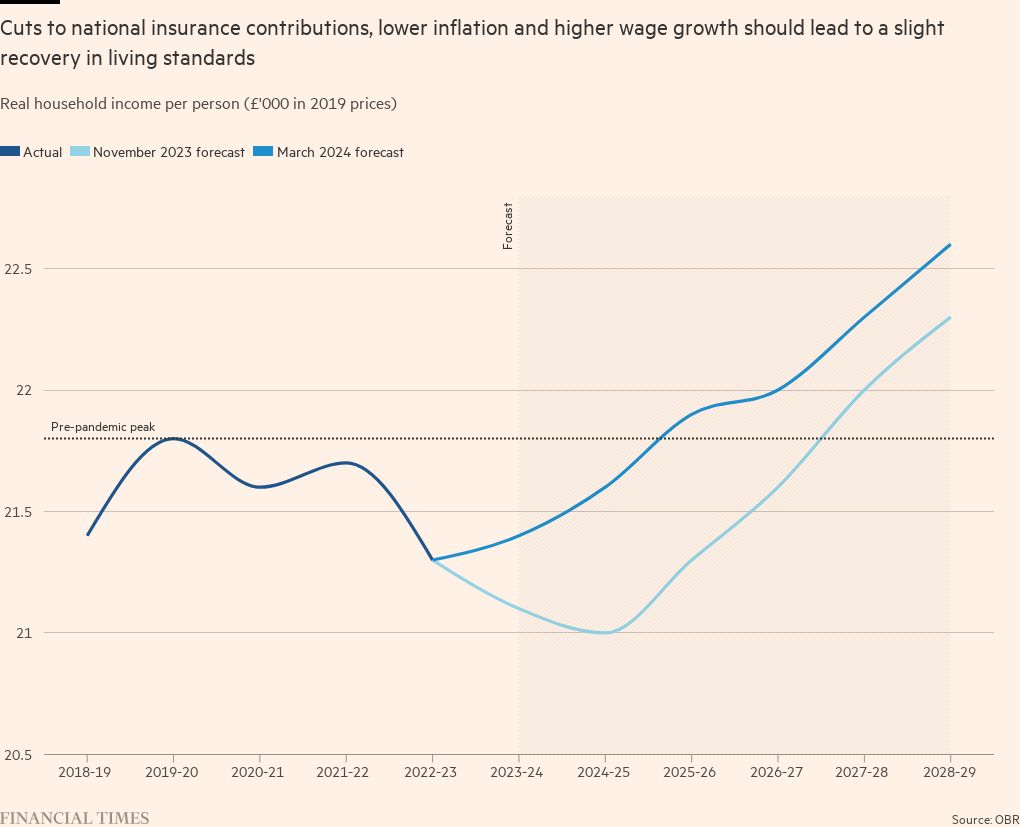Jeremy Hunt assured voters on Wednesday that his tax cutting Budget would raise long-term growth by helping people into work, rather than relying on “unlimited migration”.
But the latest forecasts from the UK’s fiscal watchdog were at odds with the chancellor’s assertion that his plans would secure “not just higher GDP but higher GDP per head”.
Although the outlook for both inflation and interest rates has improved since the Office for Budget Responsibility last published economic forecasts in the autumn, it saw virtually no change in the UK’s growth prospects.
GDP was set to grow 0.8 per cent in 2024, with stronger growth of 2 per cent by the middle of the decade and no change in the economy’s long-term trend rate — figures that still make the OBR more optimistic than other forecasters.
The OBR said the main change since its November forecasts was a big increase in its estimates for the size and growth of the UK’s adult population, which it now thinks will contain 1mn more people by the 2028-29 fiscal year. This is twinned with a worsening trend in inactivity among the working-age population, which the OBR expects to continue despite Hunt’s efforts to incentivise work.
Richard Hughes, the OBR’s chair, said these two effects “almost fully offset” each other, with the watchdog’s forecasts showing GDP just 0.1 per cent higher in 2028 than it had expected in November and per capita GDP almost a full percentage point lower.
If net immigration turned out to be much higher or lower, Hughes added, it would have a “meaningful” effect on the overall size of the UK economy, but “makes much less difference to GDP per person”.
Hunt’s cuts to national insurance contributions, combined with lower inflation and stronger wage growth, will help fuel a modest recovery in living standards, however.
The OBR said real household disposable income per person, a measure of living standards, had already returned to growth following a record fall in 2022-23, and was now set to regain its pre-pandemic peak in 2025-26, two years earlier than the fiscal watchdog had expected in November.
The 2 pence cut to national insurance contributions announced this week would directly boost real household incomes by 0.5 per cent, the OBR added, following a similar sized boost from the cut announced by Hunt in the autumn.
But economists said the Budget’s overall impact on growth and the outlook for monetary policy would be limited.
David Page, economist at Axa Investment Managers, said it would provide “only a marginal boost to an economy in recession at the end of last year”, with no impact on the projected path for Bank Rate, adding it was “doubtful we will see much of a boost to the Conservatives in the polls”.
Meanwhile the latest tax changes will only partly offset the money taken from taxpayers since 2021 through multiyear freezes to personal tax thresholds and allowances.
The biggest winners from the measure will be working-age adults in the middle of the earnings distribution. The Institute for Fiscal Studies think-tank said those earning between £32,000 and £55,000 a year would now be helped overall by 2027-28, even after factoring in all the changes made since 2021.
“Overall about a third of employees will still be better off . . . Taxpaying employees earning less or more than that will lose”, the IFS said.
The Conservative party looks unlikely to gain much electoral advantage from the modest pick-up in household incomes, however.
Paul Johnson, director of the IFS, said living standards remained “dismal” with households set to be worse off on average at the next election than they were at the last, following “nugatory” real earnings growth.
The bigger long-term concern, however, is that neither the national insurance cut nor other policies Hunt has announced over the past year look likely to overcome one of the biggest obstacles to raising the UK’s long-term growth rate: the worsening trend in economic inactivity, which is squeezing labour supply.
Hunt presented his tax cuts, free childcare expansion, and changes in eligibility for benefits as ways “to grow the economy by rewarding work”. On the OBR’s calculations, the national insurance contribution cuts alone would “mean the equivalent of 200,000 more people into work — filling one in five vacancies,” he claimed.
But the OBR said the net effect on labour supply over the next five years would be smaller than this after taking account of the effects of frozen tax thresholds, which will lead some people to work less.
Meanwhile the underlying trends in the workforce now look even worse than they did in the autumn, because new data shows the population contains more women and young people — who tend to work shorter hours — and more people with long-term health problems preventing them from working.
Hughes said the overall rate of workforce participation now looked likely to fall over the next five years, rather than making the partial recovery the OBR had counted on in November.
Labour market experts said that while cutting employee taxes was welcome, it would not address the root causes of the problem, including the rising burden of ill health.
“Health policy is economic policy and requires more ambition from government,” said Ben Willmott, head of policy at the CIPD body for HR professionals, who noted the lack of any action by the chancellor to improve statutory sick pay and occupational health services.
“Good health and a thriving economy are inexorably intertwined,” said Jennifer Dixon, chief executive of the Health Foundation think-tank, adding that even the £3.5bn top-up to NHS spending announced by the chancellor would not significantly change long waits for patients.
Neil Carberry, chief executive of the Recruitment & Employment Confederation, said: “If the chancellor’s goal was to stimulate investment and drive per person growth, he hit the post . . . It didn’t add up to the industrial and workforce strategy we really need.”















